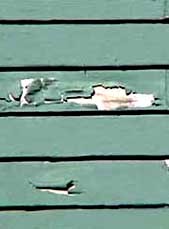
Green lawns, healthy plant material and beautiful, blooming flowers will surely increase the curb appeal of your community and home. It's all about what one sees when visiting a property. Curb appeal is greatly affected by not only the landscape but by the condition of the building's paint. Cracked, flaking or peeling paint will decrease curb appeal and usually represents deferred maintenance. Often, associations only realize their painting needs when there is major paint failure. Usually, when it gets to this point, painting the project is a huge expense and a monumental undertaking for the Board of Directors.
There is a more practical and effective method to approach an association's painting needs.
Implementing a painting maintenance program is a simple, manageable method toward protecting and maintaining an association's common area painted surface components. Many associations already have funds to start a program today. Reserve dollars are set aside each month to allow for painting, with the dollars being accumulated for a full repaint upon the end of the "useful life" of the painted surface. With a written plan is in place describing what is going to be painted each year, those same dollars can be used to develop a painting program which eliminates or minimizes the need for a full project repaint.
Painting Expense
The major expense in a repainting project is in the labor cost. Proper preparation for painting is usually one of the most important parts of the job. If the painting program addresses those areas that need the paint first, your labor costs for preparation can be kept to a minimum.
Paint Maintenance
To develop an ongoing maintenance program, confirm what areas the association is responsible for. The Board of Directors, together with a qualified painting maintenance contractor, can use the Reserve Study as a guide to establish useful life. Use a contractor with experience and a track record to help develop the plan. Ask for written documentation as the plan is implemented, so the Board is informed and can monitor the progress of the plan. Maintain a relationship with the contractor and do regular walkthroughs, so you can make necessary modifications to the plan.

The best approach to caring for your property is to have a maintenance plan in place.
- Wood surfaces typically have a four-year cycle on repainting.
- Stucco should usually be scheduled for repainting at least every ten years.
- It's recommended that iron be painted every one to two years.
- Keep plant material and irrigation away from buildings and fences.
- Lubricate hardware to keep doors and gates operating smoothly. Avoid paint being rubbed off needlessly and damage to door casings and gates.
- Clean gutters and downspouts to ensure that water runoff doesn't stain or deteriorate buildings.
- Keep painted surfaces covered with paint. It's the best way to avoid wood rot, rust, and pests (termites hate paint).
- Wash stucco surfaces at least annually to remove algae and dirt. Touch up as needed.
- Have a regular building inspection, at least quarterly, to spot issues when they are small and minor.
- Work with licensed professionals that you trust and that will serve as your on-going paint maintenance team.
Practical painting, as we call it in my firm, makes dollars and sense for the cost conscious homeowner association. Give it a try!
 Print
Print Email
Email







